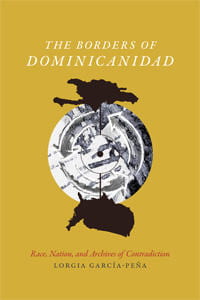A Review of The Borders of Dominicanidad: Race, Nation and the Archives of Contradiction
Being Dominican

The Borders of Dominicanidad: Race, Nation and the Archives of Contradiction by Lorgia Garcia-Peña (Durham: Duke University Press, 2016, 274 pages)
This book by Harvard Professor Lorgia Garcia-Peña embarks on an ambitious exploration of the limits of Dominican identity seen through the prism of culture, geography and race. Specifically, it focuses on the Dominican Republic and Haiti, Caribbean nations that share the island of Hispaniola and many other symbolic spaces. They share a history of colonialism and exploitation that binds them closely, on top of political and economic rivalries that afflict them. As the author says “The Borders of Dominicanity brings Dominicanism from the footnote to the center of the page, insisting on the impact of dictions on the national and racial identity of a people. The stories and histories upheld by nations and their dominant archive create marginality through acts of inclusion, violence and silencing. Though these official stories of exclusion are influential in bordering the nation and shaping national identity, this book also shows they are always contested, negotiated and redefined through contradictions.”
This work looks at the migratory experience of Dominicans who, upon arriving in the United States, face the racialization of their identity according to U.S. codes that are considerably different to their own notions. When Dominicans emigrate to the United States they are classified as black—a category that in their homeland is reserved for Haitians— and as immigrants, producing a double exclusion that conditions their possibilities of mobility and integration. Thus, the Dominicans’ identity combines three aspects (Dominican Republic/Haiti /United States) as they claim a place in the United States.
For purposes of this interpretation, the modern history of the Dominican Republic is analyzed in the context of the 19th-century imperial expansion of the United States, which included the purchase of French Louisiana, the annexation of Mexico, and the conquest of Guam, the Philippines, Hawaii and Puerto Rico during the Spanish-American War. These events created a new reality based on the integration of new colonized subjects into American society. The Dominican Republic is considered by many in the United States to be superior to Haiti in racial terms. New categories emerged from this view, differentiating one country from the other, and they extend in complex ways until today. In the words of the author, the book “is a project of recovering and historicizing knowledge interruptions through what I call contradictions, dictions-stories, narratives and speech acts that go against the hegemonic version of national identity and against the mode of analysis we tend to value historically accurate or what most people call truth.”
In its approach to the topic of Dominicanism, the book reminds us of other books about the Spanish Antilles, such as those by Fernando Ortiz on Cuba and Ricardo Alegría on Puerto Rico, that sought to identify the essential cultural elements of these countries. Both Cuba and Puerto Rico have experienced important migratory waves that have given life to communities in the diaspora that inform their notions of identity. However, the situation of people in the Dominican Republic and Haiti, as inhabitants of the same island, is exceptional.
An essential part of the analysis is the concept of “Nié,” attributed to the artist Josefina Báez, that conceives the flagless nation of Nié as a space of dual marginality, neither here nor there. The ambiguity explains the unstable terrain where different categories are built and rebuilt. The author studies how Dominicans negotiate the plural and unequal categories that inform social, historical and economic notions. In addition, she explores the ways in which the body becomes a zone of conflict through the sexualization of the individual, especially in the context of the migrant who arrives in the United States. Each of these experiences builds an archive, and that archive is studied to understand how it is constituted and updated. In addition, not only actions but also omissions are also considered, as affirmations and silences are central to understanding how the production of knowledge is colonized. “This book suggests the border between Haiti and the Dominican Republic as a locus for understanding how race and nation intersect in the bordering of a people. As people and ideas travel back and forth, borders are reaffirmed, contested and redefined through official and unofficial actions.”
The book’s exploration of identity, body and borders also extends beyond Dominicans to the notion of Latino/a, a construct of social and historical processes in the United States that render Latinos/as as foreigners. By making this clear, the book is a contribution to the emancipation of translocal histories and of individuals as well.
Related Articles
A Review of A Promising Past: Remodeling Fictions in Parque Central, Caracas
A beacon of modern urban transformation and a laboratory of social reproduction, Parque Central in Caracas is a monumental enclave of 20th-century Venezuelan oil-fueled progress. The monumental urban structure also symbolizes the enduring architectural struggle against entropy, acute in a country where the state routinely neglects its role in providing sustained infrastructural maintenance and social care. Like other ambitious modernizing projects of the Venezuelan petrostate, Parque Central’s modernity was doomed due to the state’s dependence on the global oil economy’s cycles of boom and bust.
A Review of Bodies Found in Various Places
This bilingual anthology of Elvira Hernández, translated by Daniel Borzutzky and Alec Schumacher and published by Cardboard House Press, offers a comprehensive entry point into the work of the Chilean poet. The translators’ preface offers a valuable introduction that provides important context to her work and explains aspects of her poetry present in the volume, such as Hernández’s self-effacing “ethics of invisibility,” an ars poetica in which the poems stand in front while the poet hangs back, in a call to observe rather than to be observed. In this sense, Hernández has long written from the edges of Chile’s public life, partly by choice, partly by necessity: her birth name is Rosa María Teresa Adriasola Olave, but she adopted the pseudonym of Elvira Hernández under the Pinochet dictatorship.
A Review of An Ordinary Landscape of Violence
When first reading the title, An Ordinary Landscape of Violence, I asked myself if there is really anything “ordinary” about a landscape of violence? Preity R. Kumar argues that violence is endemic to Guyana’s colonial history and is something that women loving women (WLW) contend with and resist in their personal and public lives.




